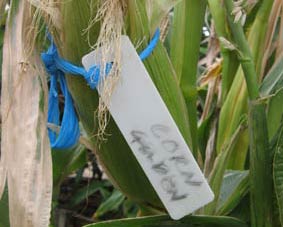seed saving
seed labelling and storage
labelling seed source plants
Why Label seed source plants?

Red Oak and Corel lettuces going to seed. They have been marked with plastic labels attached to small rose stakes. They have also been tied to larger stakes for support.
1. reduce the risk of
mislabelling the plants as they mature
While many vegetables (such as lettuces) look very different when
young, as they go to seed they begin to look more and more like each
other. Once fully mature it is easy to confuse plant varieties,
especially if you are saving seeds from a number of different varieties
of the same plant.2. avoiding accidentally
eating your seed plants
Labelling your seed source plants alerts other members of your family
that this is a seed plant and is not to be harvested as food.Seed source plant labels

Seedling label with string attached and unmodified label

String seedling label tied to cob of corn. Not only does this identify the type of corn but it alerts people not to harvest it for food.
I use three types of labels to mark plants or individual seed pods that have been marked to be harvested for seed. All of them are based on plastic seedling labels. I use plastic seedling labels as they can be written on with a pencil, rubbed out and written on again, so they can be reused many times. Plastic seedling labels can be bought from most hardware stores and nurseries. You could also get a sheet of white plastic and cut it up into rectangles.
1. plastic seedling labels
tied to strings
Plastic seedling labels are for labelling
small seedlings in seedling trays and are not really suitable for large
plants. However if you drill holes in the ends of each label and
thread a pieces of string through those holes then the strings can be
used to tie the labels to the main stems of a plant. But what I
mainly
use them for is to mark individual large seed pods such as eggplant,
corn or capsicum. I tie them around the actual seed pods or on the
stems just below the pods. Note that I cut the stands of the labels off
as they are not needed.2. Plastic Labels on Plantsman's Markers

Plastic label riveted
to a plantsman's marker.
A plantsman's marker is a generic term, but I am referring to the one's sold by the Diggers Seed Club. Their markers are thin galvanised steel plates with attached wire rods that can easily be pushed into the ground. For more information on the Diggers Seed Club click HERE. Diggers is based in Australia but they will also accept international orders.
As well as labelling seed plants these labels are also useful for marking beds that have just been planted with seeds.
3. Plastic labels on rose
stakes

The top part shows a plastic seedling label attached to a small rose stake. The bottom part is a close up of the rear of the labels, detailing the micro stray clamp and the screws used to attach it,
These rose stakes are plastic coated metal rods. The stakes and micro spray clamps are readily available from most Australian nurseries and hardware stores.

